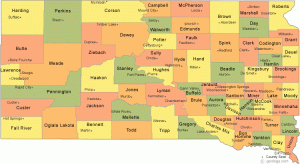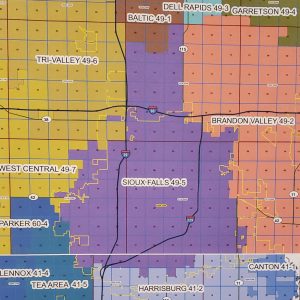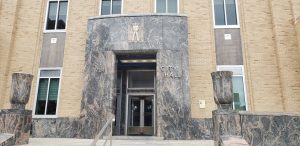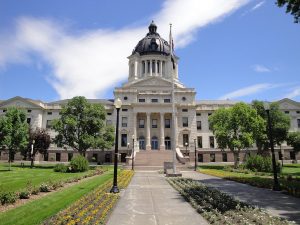Property taxes are painfully high in South Dakota for some taxpayers, and they continue to rise. One contributing factor may be the excessive number of governments and unnecessary public employees in the state.
Too Many Governments
South Dakota has the second most governmental units per capita in the country. The state’s government infrastructure was established over a century ago for population growth that never materialized. As a result, it now has a multitude of unnecessary and costly local governments. According to Governing magazine, there are 1,916 local government units in the state, including counties, cities, towns, townships, villages, and school districts.
The number of school districts (not schools) is particularly excessive. Even after some consolidation efforts decades ago, over 150 school districts remain. This means paying for numerous superintendent and administrator salaries, effectively providing rural sustaining welfare through good jobs in areas with limited employment opportunities.
No small town or rural area seems inclined to give up its district, and there are similar challenges with other types of local government.
Counties Struggle to Get By
South Dakota has 66 counties, many of which are struggling to make ends meet. Lacking sufficient funds to perform their expected duties, they raise property taxes, to the dismay of taxpayers.

66 Counties in South Dakota
Last summer, the legislature acknowledged the funding issues by conducting a summer study of county funding and services. They said their study would explore policies to encourage regionalization, consolidation, or alternate provision of services to improve efficiency for county governments and taxpayers.
Perfunctory Legislative Action
Several proposals emerged from this study, and the legislature can now claim to have addressed the problems. However, their measures are mostly superficial, maintaining the status quo.

Governor Noem Signs Bill
On March 26th, Governor Noem signed SB 199 into law, making it slightly easier for counties to consider merging. While it’s a step in the right direction, voluntary mergers remain highly unlikely. Without strong leadership from the top, the state will continue to struggle under the burden of too many governments and government jobs, with taxpayers footing the bill. But this isn’t the only problem stemming from our outdated government infrastructure.
A City Divided
The city of Sioux Falls is divided by artificial and unnecessary government boundaries. School district borders within the city divide neighborhoods and separate neighbors, leading to potential differences in school start dates, holiday schedules, and other inconsistencies that don’t make sense for a single community. Additionally, districts on the city’s edges are growing rapidly, often in areas with nice new developments. This could lead to long-term negative consequences for our community.

School districts in and around Sioux Falls
Without consolidation of school districts in the Sioux Falls area, we risk having a diverse inner-city school district surrounded by wealthier, predominantly white districts, a scenario that has resulted in undesirable outcomes in many other cities. It’s an avoidable situation, but someone needs to take the lead in avoiding it.
Sioux Falls is also divided between Minnehaha and Lincoln counties. Many residents must leave the city to access county services in Canton. These outdated boundaries hinder the development of a cohesive community.
No One ‘Owns’ These Problems
I have the impression that no one in a leadership position is focusing on a long-term vision for our governments in the Sioux Falls area. Our mayor took office 6 years ago with the theme of “One Sioux Falls” to motivate city employees and the community. But I don’t believe it had anything to do with getting rid of unnecessary government boundaries in our city. And the business community, as reflected in the Chamber of Commerce and Forward Sioux Falls, seems equally uninterested in discussing the situation. They should care about this and get involved.

Mayor TenHaken’s One Sioux Falls Campaign
City government devotes a great deal of time and energy to planning. But their focus is on economic development driven growth issues. They work with financially motivated developers and development organizations on expanding infrastructure to deal with 5,000 new residents a year. They do not spend time reflecting on the long-range problems that could result from our 7 school districts and two counties.
So, our city, like our state, coasts forward toward an unplanned and uncertain future. We deserve better.

Sioux Falls City Hall
Top-Down Approach Required
Our elected state and city leaders should spend time considering our future government infrastructure. While I don’t claim to have all the facts or answers, it’s clear that no one knows how much could be saved annually. The potential savings might be significant.
We don’t know how many “extra” school administrators and county officials we have, nor do we know the “right number” of counties or school districts for a state like ours, with a small population spread over a vast area. Only a thorough study can provide these answers, but proposing such changes carries political risks.
Meaningful reductions in the number of governments and government employees will require strong leadership from the top.

South Dakota Capitol
First Steps
The first step could be an independent study of alternative ways to deliver necessary government services. An objective task force of South Dakotans, including some legislators but primarily others who can rise above politics, could oversee this study and propose significantly improved options.
Start from Scratch
Imagine starting with a clean slate, creating a logical new infrastructure for delivering government services based on modern communication and transportation realities. This plan would likely bear little resemblance to the current system and would probably result in fewer counties and school districts, reducing government costs and easing the tax burden on property owners.
Perhaps consolidation is a topic candidates for governor and mayor should be talking about leading into the next election.
Yes, there are too many counties and school districts. There probably are too many townships, also. Minnehaha and Lincoln counties should show political courage and leadership by initiating merger discussions.